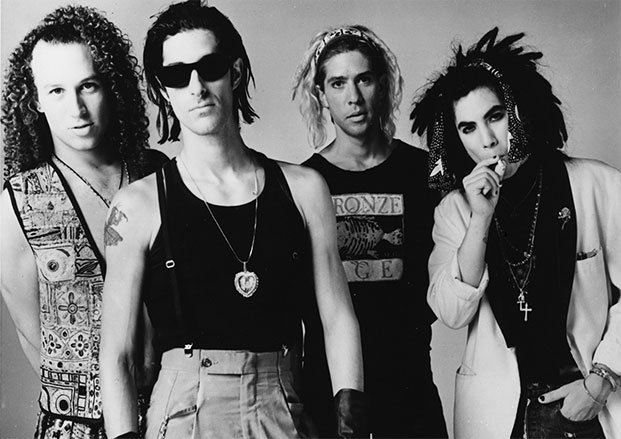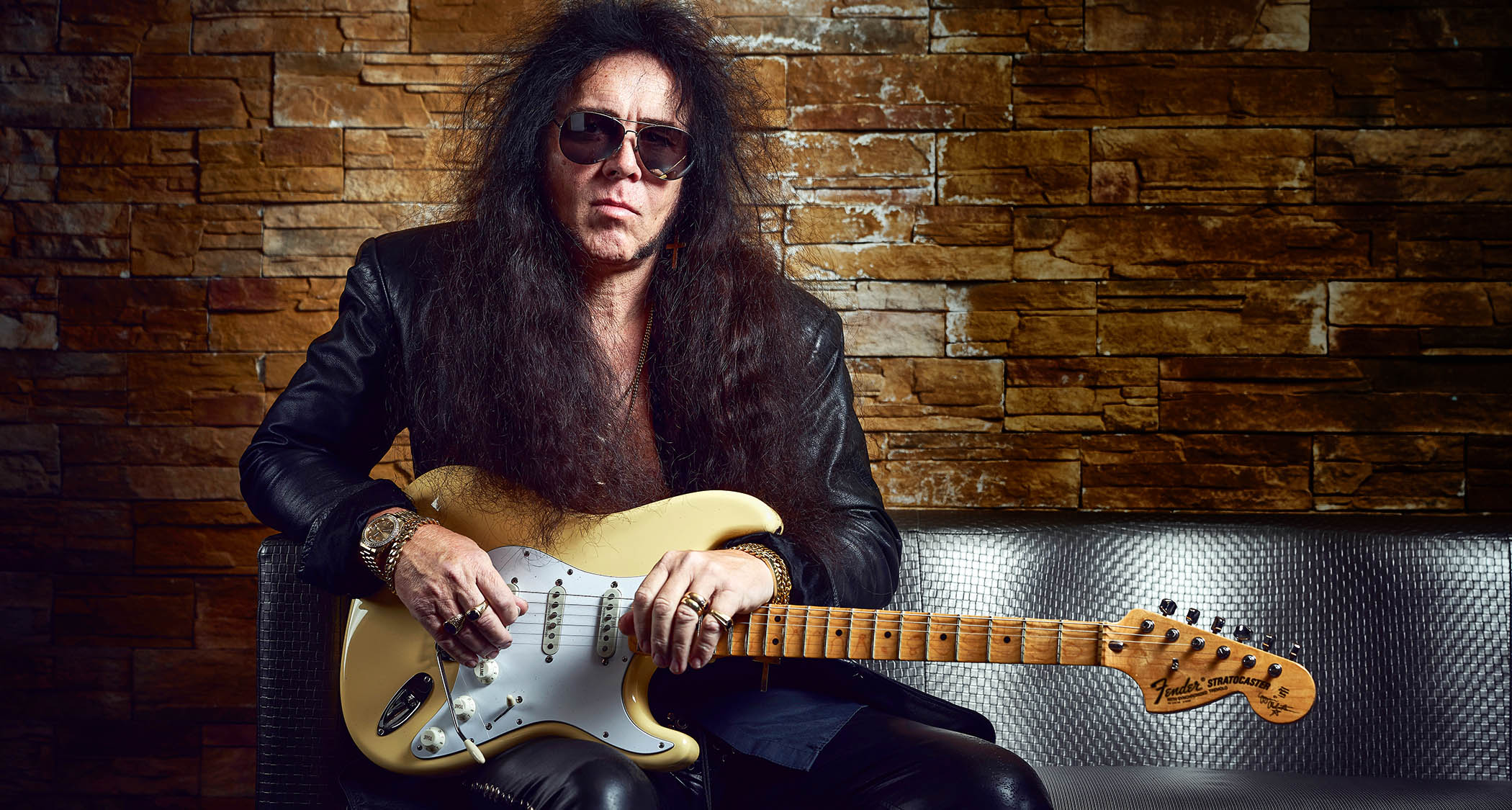Perry Farrell and Dave Navarro Recount Jane's Addiction's Spectacular Rise and Fall

Bands that burn hot and fast like Roman candles—they’re closer to the truth of rock and roll than well-adjusted veterans. Jane’s Addiction weren’t meant for the long haul.
They arrived like a stink bomb, jolting the giants of hair metal off their late-Eighties pedestals.
Anticorporate in nature, they nonetheless stole MTV’s limelight, cramming vegetables into unlikely places and dashing for the supermarket door in the legendary “Been Caught Stealing” video. They turned their fans into happy thieves. If you were into punk or metal—a culture-jammer or a tripped-out hippie chick swirling in the front row—you could love them. They pointed toward something rawer on the horizon, the flannel-checked shape of grunge.
Twenty-five years after their bitter, premature 1991 farewell (after only two studio albums), the band’s twin magnetic poles—volcanic lead guitarist Dave Navarro and soulful singer and lyricist Perry Farrell—still have disparate views about what exactly went down.
“As far as I know, we were just doing what we did,” a no-bullshit Navarro tells Guitar World from Los Angeles. “We wrote songs, toured them, played them, got them together and recorded them. The process was much truer and less product-oriented than it is now.” Navarro makes no mystery of his spotty memory, wrecked by serious drug use, the spoils of fame and musical exhilaration: “It was a very convoluted time,” he explains.
Farrell, soft-spoken and thoughtful, remembers something more ambitious. “What I was personally shooting for was greatness,” he says, aware of the immodesty but owning it. “I wanted to be in league with, you know, the Beatles and the Stones and the Who and Hendrix and the Doors. That was what my dream was.” Farrell, like Navarro, is a survivor. You can’t tell the story of Jane’s Addiction without a fair amount of haze. Both men will be hitting the road this summer to play 1990’s Ritual de lo Habitual, the album that crystallized their highest highs and ruinous lows. “We went for integrity,” Farrell says. “We wanted to live life and experience life and report about life on the wild side. And we didn’t apologize for it.”
We begin roughly four years in. Jane’s Addiction have already gone through four guitarists before a teenaged Navarro clicks with Farrell. They’ve commandeered the Sunset Strip club scene, particularly the sweaty stage at Scream, where Guns N’ Roses and the Red Hot Chili Peppers cut their teeth. Warner Bros. have signed them with an advance rumored to be the largest in the label’s history. The group quickly records a self-titled live album in 1987, then their first studio album, Nothing’s Shocking, the next year. Heavy touring commences.
Get The Pick Newsletter
All the latest guitar news, interviews, lessons, reviews, deals and more, direct to your inbox!
“I somehow lucked out,” Navarro says, “being able to hook up with these guys who were coming from a really artistic place. I feel like I’m one of the rare guitarists who 'got away with it'—got away with being part of that technical metal world that was happening at the time, but also had a foot planted in the alternative world. I’m very fortunate.”
Farrell, for his part, saw a kind of artistic completion in Navarro. “The minute he arrived, I just had this feeling we were going to be able to do it,” he recalls. “We were going to be remembered. We were going to have parts that the world would air-guitar to.”
As complex as Jane’s Addiction’s music could be—loaded with calypso steel drums, strummy folk idylls and screaming solos in a Jimmy Page mold—it’s worth noting how out of step their lyrics were with the prevailing mood, one best summed up by Tawny Kitaen squirming on a car hood. Farrell was more liberated than most. “How about the fact that we were speaking about women not as ‘cherry pies’ but as ‘classic girls’?” he snipes. “How about we took the misogyny out of the music that was currently happening? And we made it important to be romantic and look at your significant other like a person you got ideas from.”
Farrell’s mother as well as his artist girlfriend took their own lives, the former when he was only three. It's a large part of his feminism. Suicide haunts Ritual’s powerful track “Then She Did…,” a standout on a collection of songs that was slowly coming into focus, alongside many cultural influences, especially the Angelino presence of Caribbean Santería art with its vivid mix of pagan and Christian. “I was really enamored and fixated on Santería stores that we have around here in Los Angeles,” says Farrell. “They’re very colorful and, at the same time, they have a great potency—a religious and magical potency. A lot of the artwork that I was doing was Latin-inspired.”
Keeping pace with the band’s artistic curiosity was a different kind of subcultural injection. “In those days, we were hitting speedballs really hard,” Farrell allows. “Our daily life would consist of waking up, going to a spoon, drawing back heroin-cocaine admixtures, slamming them and getting your day going. So that was our daily ritual. Originally, somebody came up with the phrase 'ritual of the habitual' and I thought it would be better if it came off the tongue ritual de lo habitual—again, the Latin influence made it that much more romantic and passionate.”
True to their process, the material shaped up in front of audiences, not in the recording room. “By the time we got to the studio, these songs were well-oiled, finely tuned packages,” Navarro says. “We ended up recording them pretty much live, and then Perry and I did our overdubs.”
“You can’t hide behind all the technology,” Farrell agrees. “Once you show up and you can’t sing, you’re as good as gone. We were smart in that we did it like the Grateful Dead. We built our career on our live appearances.”
Already, though, seeds of discontent were sown, unbeknownst to fans. Even as the band grew an unusually diverse audience by the millions, it was coming apart, its members the victims of an incessant touring schedule—13 months to support the new album (released in August 1990)—that wreaked havoc on an addict’s schedule.
“The breakup was based on emotional reasons,” Farrell disagrees. “I felt that I couldn’t go on expressing ideas because they were getting constantly knocked down. Everything I brought up was looked at with disdain, negativity. We were at the top—the top of our game, the top of the world. But artistically, I had run up against a wall. I just needed to go in a different direction. I wasn’t going to smash through the wall. I wasn’t going to try to climb over the wall. I would just simply walk in a different direction. And I knew I’d be okay, but I wish it never had to come to that."
Navarro is more blunt: “The 'why' isn’t the big mystery to me. We all know why.” He means Farrell’s intensity, but also the drugs, the fights that began spilling into their performances. “What’s unusual is that we never talked about it. I know that I went home and slammed a bunch of coke and heroin, and I know those guys did too, and we never picked up a phone again.”
But before that point, there was a tour to honor, one that was increasingly feeling like a farewell.
Ritual de lo Habitual was becoming that most unlikely of things: a multi-Platinum monster. Much of that was due to the low-budget video for “Been Caught Stealing,” a sensation when MTV still drove audiences to new music.
“You see in those close-ups, I put a stocking over my head,” Farrell notes. “I really didn’t like being even seen. I didn’t want people to know what I looked like. The idea that I would be in a pop category in any way, shape or form—other than an Iggy Pop category—made me want to slit my wrists.”
He sounds like an unlikely grocery thief, but it’s a true story. “You have to understand that we were essentially living in a house with 12 other musicians. So we didn’t have money. As a result, all the clothes that I had were thrift-store clothes, and a lot of them were stolen.”
On the phone with Guitar World, Farrell has moved into the room in his Santa Monica Canyon home where his MTV Video Music Award sits, the one for Best Alternative Video. “I’m staring at the award right now,” he says. “I didn’t go to the ceremony. To be honest with you, I thought MTV was a rip-off. They didn’t pay artists residuals. And they played the video all day. They made money off us. They got credibility off our video, they became hot shit, but they weren’t helping. As far as I was concerned, fuck them.”
Out on the road, crowds were lifting them higher anyway. “Rockers were coming to our shows,” says Navarro. “They were die-hard metal fans until they heard Jane’s Addiction. The guitar playing brought them in, but the band opened their mind to a whole other slew of music.”
The guitarist is moved by what he remembers as a spirit of change. “It was a celebration of music regardless of who you were and what you were supposed to be a part of and what you were supposed to like,” Navarro recalls. “It was more like a youth movement—that was the spirit that launched Lollapalooza.”
Farrell, widely credited with coining the term alternative nation, concurs. “We had a community of people who were not your typical Sunset Strip crowd of spandex and teased-up hair,” he says. “We were underground, hanging out with punks and gays and artists and rock and roll guys. You could look in one corner and there’d be rockabilly punk, and in another corner, there’d be hardcore punk: Minor Threat, Fugazi, straight-edge.
And then you’d look in another corner and there was us. And what was that? We were a lot of rock, but we weren’t derivative.”
Lollapalooza would become Jane's Addiction's goodbye. It was a roadshow that brought together a still-breathtaking lineup of musical nourishment: goth legends Siouxsie and the Banshees, Vernon Reid’s radical Living Colour, a pre-megafamous Nine Inch Nails, the crime-rhyme rapper Ice-T (and his controversial metal offshoot Body Count). Punks like Butthole Surfers, Henry Rollins and Violent Femmes were also represented. The Lollapalooza concept would also eventually give birth to the “second stage,” to the idea of choice within choice. You could see scary magic with the Jim Rose Circus Side Show. You could join an alternative-energy campaign. You could register to vote.
And closing out every night—at least that rudimentary first year—would be a band that, for all its internal dysfunction, was suddenly a symbol of utopian unification.
“It was crazy,” Navarro says. “We’d be playing and I’d look out and see a bunch of kids dressed like [the Cure's] Robert Smith, and I’d see a bunch of black kids, and I'd see a bunch of hair-metal dudes. And they were all just chilling together, having a blast. It was unbelievable. I’m from an era when heavy-metal kids and punk-rock kids fought each other—like fist fights! In high school, we were gangs. We would beat each other up. And then Lollapalooza happened and, all of a sudden, we were pals. God, I miss that time.”
After 40 sweltering summer days and 26 shows, the tour was over. So was the band, at least for then. Jane’s Addiction would reunite many times over the coming years, but in August 1991, the dialogue had ended. “We never had a conversation that said, ‘We’re not going to be a band anymore,’ ” Navarro recalls. “I don’t think I was really aware of that until I heard that Perry was doing Porno for Pyros.”
The guitarist is an interesting combination of old-school tech and relentless anti-nostalgia. He’ll be touring with the same gear he used back in 1991: his Paul Reed Smith guitars and pedal effects. “I actually spoke to Tom Morello recently about gear and he has the exact same amp and the exact same guitar that he’s always had,” Navarro says. “There’s something about being comfortable with things that you love. I love my Boss pedals because you can individually access them. I don’t like a bunch of rack-mounted bullshit, where I have to dig through parameters and do all kinds of math to get a sound I want. Dancing around on the pedal board is part of my performance and my playing. It keeps me on my toes, literally. There’s a Fender Twin onstage that I use for a clean sound, but that’s it, man.”
But provocatively, he has no regrets—even regarding the dangerous stuff. “It’s not something I do anymore, but back then, as a younger man, it wasn’t all bad. I’m grateful for the band because I’m the kind of guy who would have been a drug addict no matter what I was doing,” Navarro admits. “Had I been a drug addict without a job, I probably would have died. I know it’s a unique perspective but for me, my truth is that the band saved my life.” (These days, Navarro calls himself a political junkie: “My girlfriends aren't really excited about catching the new O’Reilly Factor when they come over to my house. 'Honey, the new Rachel Maddow is on!' ”
Farrell strikes a different tone. “If I'd slowed down just a little, I would have been more productive. I would have had more to say. I just kind of disappeared, you know?”
Both see Jane’s Addiction as a moment and a movement, one they let slip away but one that still shines on, darkly. Farrell tells me he's grappled with his decision to break up the band for years.
“We were just hitting our stride,” he says. “It was the worst timing. It’s like my wife always says, ‘You’re where you are now, Perry, because you chose to sing about ménage a trois and heroin. That’s your fan base, that’s your audience. If you had sung about silly love songs, you’d be bigger.' But I just couldn’t do it. I had to be who I was.”
“The main acoustic is a $100 Fender – the strings were super-old and dusty. We hate new strings!” Meet Great Grandpa, the unpredictable indie rockers making epic anthems with cheap acoustics – and recording guitars like a Queens of the Stone Age drummer
“You can almost hear the music in your head when looking at these photos”: How legendary photographer Jim Marshall captured the essence of the Grateful Dead and documented the rise of the ultimate jam band











